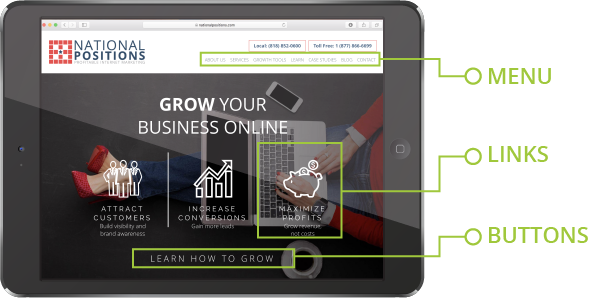
USER EXPERIENCE
As the sophistication of machine learning continues to dominate the relevance of search results, user experience (UX) has become one of the most important search ranking factors. In fact, some SEO experts will refer to user experience as the fourth major pillar of search engine optimization, on par with content, linking, and technical SEO.

HOW SHOULD YOU CONSIDER USER EXPERIENCE?
User experience is defined as providing the best possible customer journey for every single one of your web visitors.
One of the most common mistakes is considering user experience as starting at your home page. Although this may be true for many web visitors, in most cases user experience begins on pages besides the home page. When determining where to begin, your UX analysis should start with a review of your analytics and the most popular visitor entry points to your site.
HOW DO YOU MEASURE USER EXPERIENCE?
UX is more than navigation or load speed – it includes the entire user journey and experience.
Although there are many user experience metrics to consider, the most important factors are time on site (dwell time), bounce rate (how many users enter and leave the site from the same page), and page views (the number of pages a user visits during a web session).
Just as Google uses a quality score for paid search, it is assumed that their organic algorithm also scores pages by click through rate, time on site, and the number of users returning to the organic search results, presumably looking for a better search result. Other key factors to consider are conversion rates, channels, device types, and frequency of visits.
MOST COMMON USER EXPERIENCE FACTORS
The following are some of the most important factors that you should consider:
Content
How is the content on your page organized? Consider the amount of white space and how easy it is for the content to be consumed. When you think of content, think also of video and images – not only text. The freshness and quality of your content are both extremely important user experience ranking factors.
Image Density
Depending on the category and industry, image density varies. If, for instance, your site is an ecommerce site or a travel site, the density of images will be far greater than for a legal site.
Website Layout
The layout of the website includes factors such as the location of the menu, the use of colors, and the ease of use for desktop, tablet, and mobile users. Font size and location of menu items are exceptionally critical on mobile devices.
Load Speed
Google especially has been fixated on mobile load speed. Mobile users have increasingly short attention spans and have little patience for slow loading web pages. Improving load speed is often the easiest user experience factor to identify and fix.
Internal Linking
Search engines encourage easy navigation between pages. Logically linking pages into themes can help improve overall user experience and relevancy.
Ads
MOBILE AND USER EXPERIENCE

TESTING USER EXPERIENCE
User experience may be tested using conversion optimization – i.e., split or multivariate testing. Typical tests include:

Headlines

Different themes and layouts

White space

Call to action

Content layout and structure

Risk reversals

Menus

Image layout

Etc.

